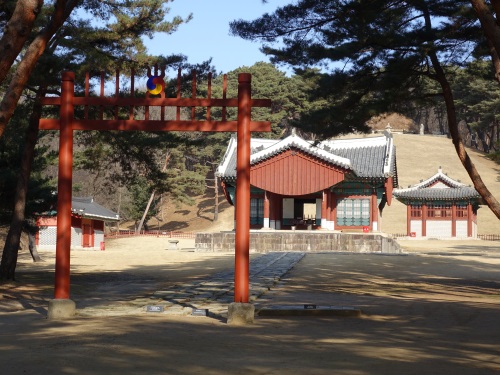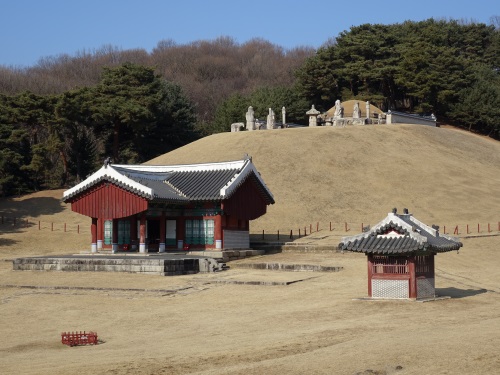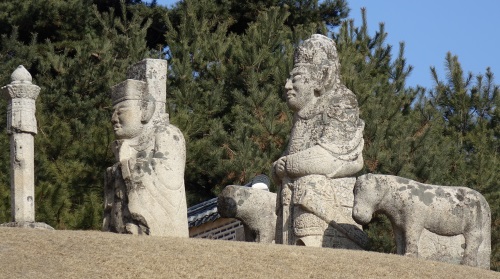Blog WHS Visits
WHS #624: Royal Joseon Tombs
With the Royal Tombs of the Joseon Dynasty, I ‘finished’ South Korea’s batch of 12 entries on the current World Heritage List. Like many of the others – 6 to be precise – it lies well within the range of the Seoul Hotspot. The Joseon Tombs comprise 18 different locations, of which I chose the Donggureung Cluster to visit - “the largest and most attractive” according to the Lonely Planet ánd our own South Korea expert Kyle Magnuson.
 Donggureung lies in Guri, a city typical for the Seoul metropolitan area with its many numbered grey high-rise apartment blocks. The bus driver alerted me where I had to get off the bus, but I had seen it already myself as there are big signs in Korean and English pointing to this royal cemetery. Despite the urban setting, this is a peaceful location in a forested area. There were few other visitors when I arrived on a Friday morning, only a couple of the ubiquituous Korean pensioners and even a small group of birders. Entrance costs a nominal 1,000 Won (ca. 0.80 EUR).
Donggureung literally means "East Nine Royal Tombs”: there are 9 tombs that hold the remains of 17 Joseon kings and queens. Each of the nine has a separate setting in the forest, and they are linked by paths. The paved paths behind the entrance gate to each tomb follow the same principle as those at the Jongmyo Shrine: the central path is for the spirits (not to be walked on by mere mortals), the one alongside is for the kings (which nowadays may be used by normal visitors). Each path ends at a pavillion, and behind it lies the actual tomb on a hill. One of the unfortunate circumstances of Donggureung is that it is forbidden to get close to the hill-tombs - you have to stay behind a fence.
Donggureung lies in Guri, a city typical for the Seoul metropolitan area with its many numbered grey high-rise apartment blocks. The bus driver alerted me where I had to get off the bus, but I had seen it already myself as there are big signs in Korean and English pointing to this royal cemetery. Despite the urban setting, this is a peaceful location in a forested area. There were few other visitors when I arrived on a Friday morning, only a couple of the ubiquituous Korean pensioners and even a small group of birders. Entrance costs a nominal 1,000 Won (ca. 0.80 EUR).
Donggureung literally means "East Nine Royal Tombs”: there are 9 tombs that hold the remains of 17 Joseon kings and queens. Each of the nine has a separate setting in the forest, and they are linked by paths. The paved paths behind the entrance gate to each tomb follow the same principle as those at the Jongmyo Shrine: the central path is for the spirits (not to be walked on by mere mortals), the one alongside is for the kings (which nowadays may be used by normal visitors). Each path ends at a pavillion, and behind it lies the actual tomb on a hill. One of the unfortunate circumstances of Donggureung is that it is forbidden to get close to the hill-tombs - you have to stay behind a fence.
 The most interesting among the tombs here, one with a real Wow-factor, is that named ‘Mongneung’. It has 3 different graves in a wide open, grassy area. Each is located on a separate hill. The furthest of the 3 is the only one in the whole area that can be climbed, so you can have an up-and-close look at the stone objects that decorate the graves. Many of these are similar, and represent soldiers and government employees that stand guard.
I also enjoyed just roaming the paths of the forest where the tombs are located at. In addition to a few bird species, bigger animals seem to visit the grounds too: I noticed signs (in Korean only) displaying a warning about a beast resembling a wild boar.
The most interesting among the tombs here, one with a real Wow-factor, is that named ‘Mongneung’. It has 3 different graves in a wide open, grassy area. Each is located on a separate hill. The furthest of the 3 is the only one in the whole area that can be climbed, so you can have an up-and-close look at the stone objects that decorate the graves. Many of these are similar, and represent soldiers and government employees that stand guard.
I also enjoyed just roaming the paths of the forest where the tombs are located at. In addition to a few bird species, bigger animals seem to visit the grounds too: I noticed signs (in Korean only) displaying a warning about a beast resembling a wild boar.
 Like Korean food, most of the Korean WHS are not as accessible as their Japanese or Chinese counterparts and require an ‘acquired taste’. In contrast to the other main Northeast Asian countries, Korea isn’t overly Buddhist (Christianity even is the main religion nowadays) and the sites in and around Seoul are mostly Confucian - with its often difficult to grasp concepts and rites for an outsider. To me though, these Joseon tombs are very much worth their spot on the List for their atmospheric setting and testimony to a very distinct royal burial practice.
Like Korean food, most of the Korean WHS are not as accessible as their Japanese or Chinese counterparts and require an ‘acquired taste’. In contrast to the other main Northeast Asian countries, Korea isn’t overly Buddhist (Christianity even is the main religion nowadays) and the sites in and around Seoul are mostly Confucian - with its often difficult to grasp concepts and rites for an outsider. To me though, these Joseon tombs are very much worth their spot on the List for their atmospheric setting and testimony to a very distinct royal burial practice.
Overview of the basic lay-out of each tomb
Mongneung tombs
Close-up of the stone figures "guarding" the grave
Els - 21 January 2017